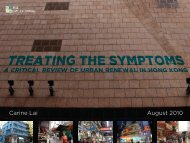Untitled - Civic Exchange
Untitled - Civic Exchange
Untitled - Civic Exchange
Create successful ePaper yourself
Turn your PDF publications into a flip-book with our unique Google optimized e-Paper software.
SUSTAINABLE TRANSPORT IN HONG KONG: DIRECTIONS AND OPPORTUNITIES<br />
the corner" since the 1960s. By the late 1970s, such promises were already beginning to wear thin. 185 Even<br />
now, more than two decades later, there have been only modest advances.<br />
The high optimism with respect to electric battery vehicles was based on presumed advances in batteries<br />
based on something other than lead-acid (e.g., nickel-cadmium, nickel-zinc, sodium-sulfur, lithiumchloride).<br />
Of these, only nickel-metal hydride and nickel-cadmium batteries have seen even very limited<br />
application. And while there have been some advances in battery storage over the last several decades,<br />
lead-acid batteries (basically much larger versions of standard car batteries) still power the overwhelming<br />
share of electric battery vehicles as they did in the 1970s. 186 Even today, electric battery vehicles suffer<br />
from inconveniently long recharge times and limited range between recharges, regardless of the battery<br />
employed. Disposal of used batteries also presents a potential problem if the electric vehicle fleet becomes<br />
even moderately large.<br />
For a place like Hong Kong, it would be best for the government to keep an eye on electric battery vehicle<br />
technology and, more importantly, its application elsewhere. When and if electric battery vehicles prove<br />
viable in other urban areas, the government should work with private vehicle fleet operators to offer<br />
incentives for local testing. Indeed, in 2001, the Hong Kong government ran a testing program for electric<br />
public light buses (PLBs). In this trial, electric battery vehicles with current battery technology were found<br />
to have some limitations, including a lengthy recharging period.<br />
The exaggerated expectations for electric battery vehicles should serve as a cautionary note on fuel cell<br />
vehicles. In the late 1960s and 1970s, a considerable amount of work and large expenditures of research<br />
and development funds were devoted to electric battery vehicles. Indeed, the very extent of the literature<br />
on the research and development of such vehicles seemed to imply that the needed technological<br />
breakthroughs surely must come soon. Today, the literature on fuel cell vehicles may have created the same<br />
impression. However, simply applying more money and effort to develop fuel cell or electric battery<br />
vehicles is no guarantee that essential advances will be forthcoming.<br />
Our motivation for stressing caution with respect to electric battery vehicles and fuel cell vehicles is a fear<br />
that waiting for advanced technology may become a means of avoiding more basic changes. By the time<br />
we realize that the presumed major technological breakthroughs may not be forthcoming, we will have lost<br />
precious years in implementing simpler alternatives that are known to work today.<br />
5.4 Recommendations for making road transport in the HKSAR more sustainable<br />
1. Far better coordination between buses (and PLBs) and rail is urgently needed, including<br />
the creation of feeder bus (and feeder PLB) routes between rail stations and high-density<br />
developments.<br />
2. Although the HKSAR has high rates of bus ridership, there is much more that could be<br />
done to improve load factors, including an assessment of the extent to which electronic<br />
road pricing (ERP) could facilitate use of high occupancy public transport and discourage<br />
companies from putting empty buses on the road in highly congested areas.<br />
54<br />
185 Barron, W., Crawford, E., and Weinberg, M. (1978), The Outlook for Alternative Fuel Supplies and Vehicle<br />
Engines, 1985-2010; Implications for Transportation and State Tax Structures, Baltimore: Center for Metropolitan<br />
Planning and Research, The Johns Hopkins University.<br />
186 Transport Department (1999), Third Comprehensive Transport Study: Strategic Environmental Impact<br />
Assessment.

















